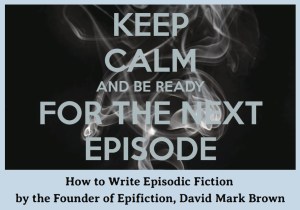 In case you've been so busy shielding your mountain compound against high altitude nuclear EMPs for the last couple of years that you've missed it, let me reiterate—the rules for writing and publishing have been burned and rewritten so many times, they no longer exist.
In case you've been so busy shielding your mountain compound against high altitude nuclear EMPs for the last couple of years that you've missed it, let me reiterate—the rules for writing and publishing have been burned and rewritten so many times, they no longer exist.
Episodic Fiction May or May Not be for You
In the wake of the publishing apocalypse, dozens of templates on how indie authors should pursue success have emerged. Most of them probably work, when taken in context. Let's face it, every writer's context is different, and (as any blogger knows) when you stretch a template too far things will get ugly.
Rapid Release Publishing as a Means of Meeting Reader Demand
But I absolutely believe episodic fiction will exponentially increase in popularity as the digital revolution continues. The internet is the ideal environment for episodes and episodic story-telling.
- Readers desire repeating content
- Readers want to invest once and benefit over and over
- Readers don't want to wait (long) for the rest of the story
- Readers don't want to pay big bucks for digital content
- Page length is meaningless on a screen
- Story is still supreme
These reasons and more are why episodic story structure will explode in popularity in coming years. These last few years have led to the rise of "rapid release" as a means for an author (or a team of authors) to publish novels at a rate of once per month or faster for the main purpose of keeping readers engaged. While rapid release is not always synonymous with episodic format, the two fit together perfectly. And when done via a team of authors, this format can be a happy solution for reader and writer alike.
First, a precautionary word against taking your backlist and publishing it a chapter at a time.
Chapters are NOT Episodes
Chapters can be published serially. Serial fiction refers to the process of dripping content on a regular basis over a span of time. Episodic fiction requires more than just multiple releases over time. Episodes have a distinct structure (beginning, middle, end). Episodes put unique demands on writers. Marketing and sales for episodes will evolve as they grow in popularity. These are the topics I'll spend the next days and weeks discussing in these posts:
Let's start with...
The EndGame
Television provides the largest sample base for episodic storytelling—some examples good, some bad. Not all serial storytelling has an endgame, but the good ones most definitely do.
Has anyone else noticed that The Walking Dead (comic or television) starts to get grating/irritating after a while? The reason, in my opinion, is due to the lack of clear endgame for the series. What sort of life is Rick and his group striving for? Survival can only fuel a serial for so long before the passengers become too exhausted to care.
Sticking with the same genre, the show Falling Skies does a much better job of providing a clear endgame. (In Falling Skies, the apocalypse involves aliens instead of zombies.) The survivors have the overarching goal of forcing the aliens off Earth and taking back their world. Every episode involves a new event with new problems, but the endgame repeats regularly in the hearts and minds of the main characters. They long for a day when the aliens are gone, and they'll fight until they accomplish that or die trying.
The epic Lord of the Rings remains satisfying for hundreds of pages, (and what breaks down into several episodes) because throughout everything the story remains true to the endgame of destroying the ring.
Battlestar Galactica is all about finding a home for the human race.
Even the crime drama, Castle, eventually lands on the endgame of Castle and Beckett being together and living happily ever after. (It started with the endgame of Castle shadowing Beckett for a book he was writing before picking up the obvious relationship endgame and then continuing on for one season too many...)
Most authors wouldn't try writing a book without an endgame. A serial should have one too. It just might take longer to get to. This endgame is the bigger picture story arc for the entire series. If you have a series idea, or you've already started into your series, and you can't cleanly formulate an endgame, I highly suggest you hash through one before going any further.
Most good serial storytelling includes medium sized arcs throughout. True episodic fiction also involves individual arcs for each individual episode. Together, these large, medium, and small arcs create a satisfying and compelling rhythm for the reader.
The end result created by long, medium, and short arcs in episodic fiction isn't terribly different from the arcs in a more traditional trilogy. The mental and creative process of creating these arcs takes a shift in paradigm for the author. We'll get to these shifts in the coming posts!
Please, leave any and all comments. Have an example of a serial you love that doesn't have a clear endgame? Share it!
1 thought on “How to Write Episodic Fiction (pt.1): Know the EndGame”